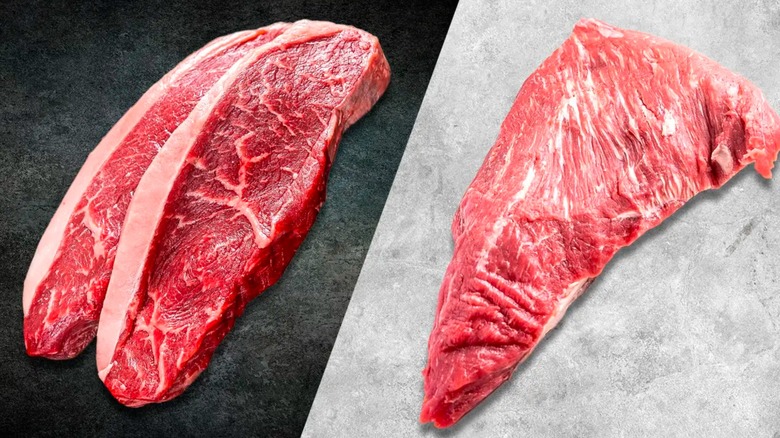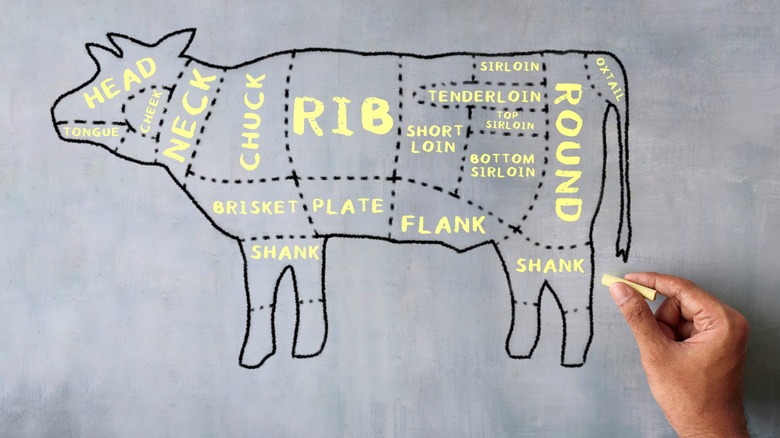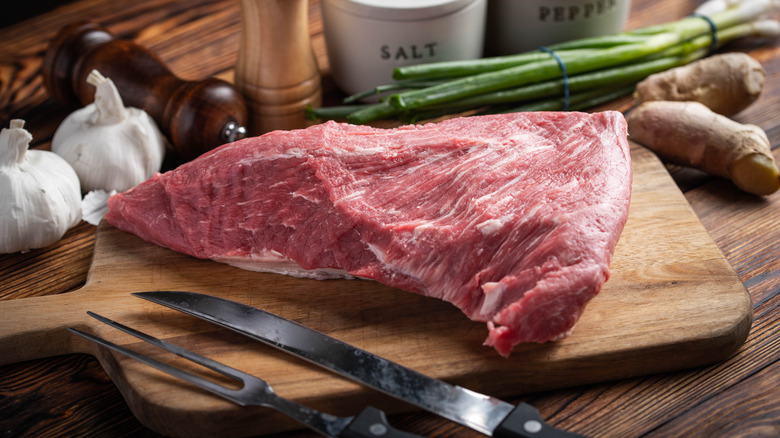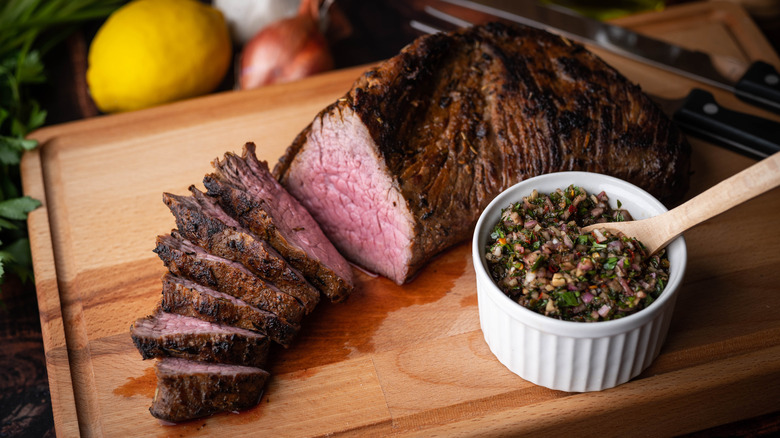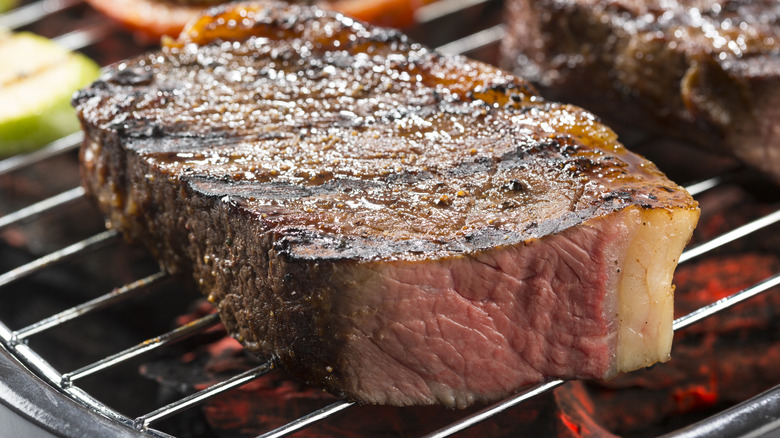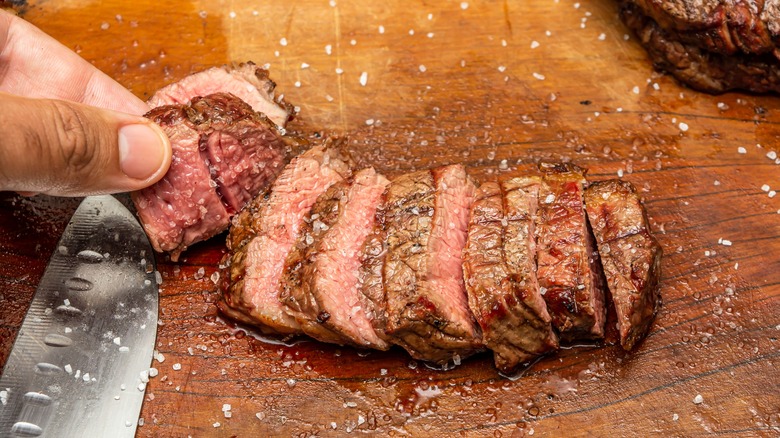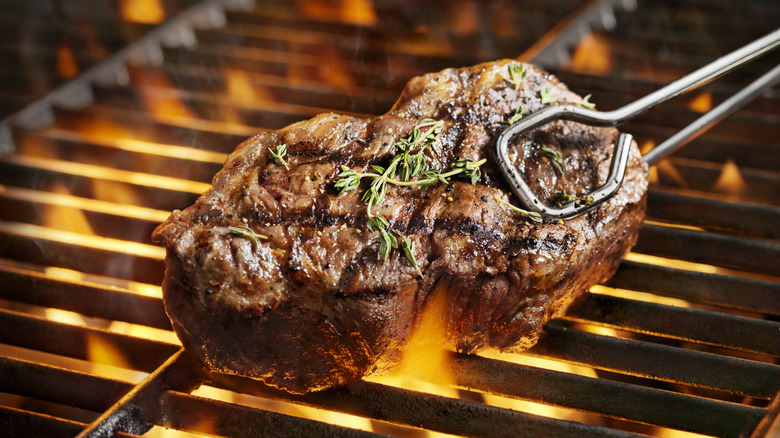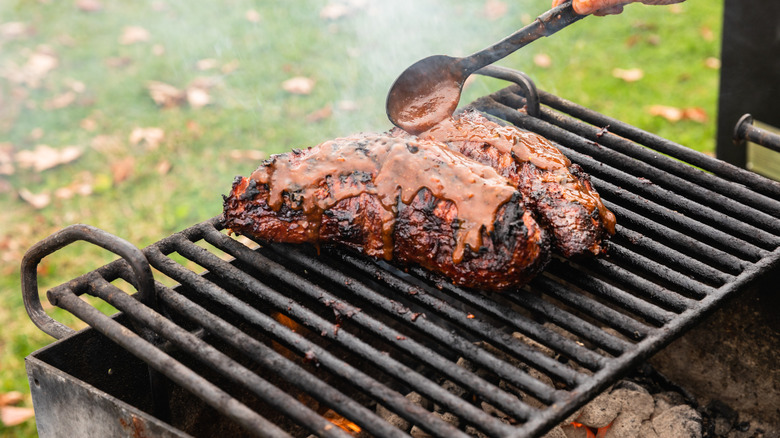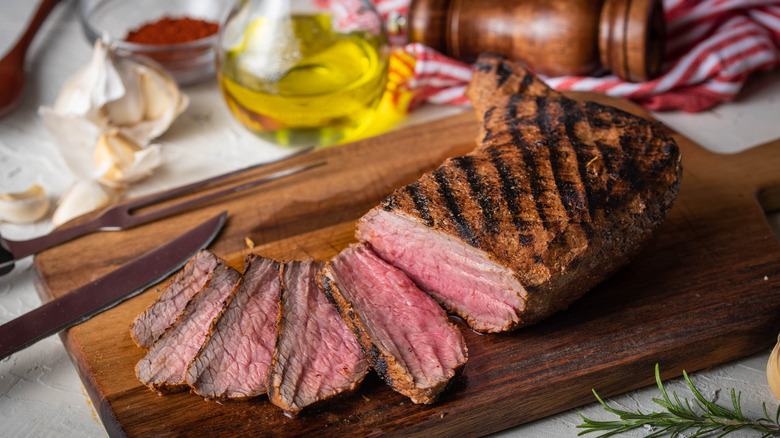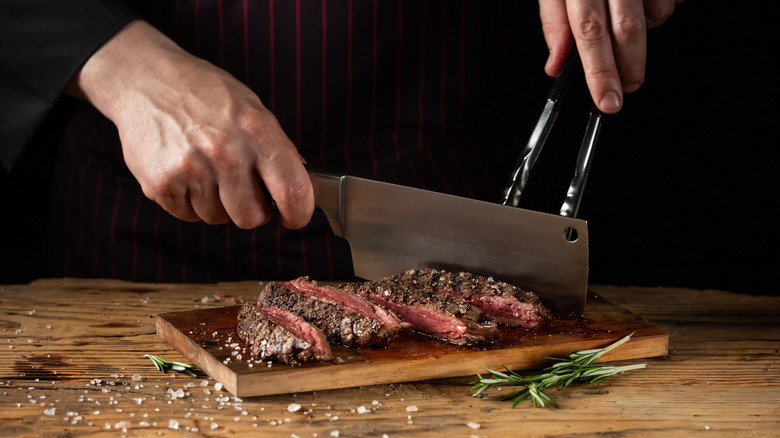Sirloin Vs. Tri-Tip Steak: The Pros And Cons You Need To Know
One can debate the pros and cons of popular cuts of meat such as sirloin or tri-tip until the cows come home, especially when they come home in the form of steak. Each of these cuts is unique in its flavor, texture, and favored preparation methods. In fact, even within the sirloin category, a range of cuts differ in their qualities and characteristics. Naturally, this means that preference plays a significant role in comparing sirloin and tri-tip steaks. To develop a preference, however, you first need to understand each steak's pros and cons.
On the one hand, sirloin and tri-tip have a lot in common. They're both from the sirloin primal cut (with the exception of sirloin tip steaks, which come from the round). This means they're both from the same section of the cow, between the ribs and the hind legs.
On the other hand, each of these two varieties of steak may be preferential in different scenarios and often cost different amounts. The world of butchers and barbecues has as much jargon as it does preferences. This can make comparing tri-tip and sirloin difficult, and finding which is truly better ultimately comes down to the experience you want to have. As a grill-obsessed South African, I'm determined to perfect the art of the steak. Paired with meticulous research, I've set out to pit these two oft-compared steaks against each other to discover the pros and cons of each.
What is sirloin steak?
Rather than referring to a specific cut of meat, there are actually several that use the name sirloin. Most originate from the sirloin primal cut; however, there are others cut from the sirloin tip section of the primal cut known as the round that uses the sirloin name as well. These include steaks referred to as sirloin tip steaks.
Common steaks from the top sirloin butt subprimal cut include top sirloin steaks and cuts such as the coulotte steak, which can also be called the top sirloin cap steak. Often, a steak simply referred to as a sirloin steak is a top sirloin cut. From the bottom sirloin butt comes the petite sirloin steak and the bavette or sirloin flap. In fact, this is the same section from which tri-tip steaks originate. These steak cuts are created by separating the muscles that weave through the sirloin and round primal cuts into sections. Doing so allows the qualities of each muscle to inform the best cooking process.
For the purpose of comparing to tri-tip, it's useful to divide the family of steaks with sirloin in the name into two main groups: the top sirloin steaks and the sirloin tip from the round primal. The sirloin primal cut can be found toward the rear of the cow, high up, and behind the animal's ribs. The round primal originates from a cow's rump at the top of its back legs.
What is tri-tip steak?
Tri-tip steak is a popular cut following a muscle group, including muscles from the thigh, originating from the bottom sirloin butt subprimal cut. Once this 1 ½ to 2 ½ pound cut is removed, the tri-tip is a long piece of beef with a characteristically triangular shape, hence the tri in tri-tip.
This is a popular choice for grilling or roasting, especially in California and elsewhere on the West Coast of the U.S., where it can also be sold under the name of Santa Maria steak or California cut. Santa Maria Valley describes that the cut was popularized in the 1950s, largely thanks to a market owner named Bob Shutz. As the story goes, Shutz redeemed the neglected cut, which had previously been relegated to being ground or chopped up for stews. He did this by giving tri-tip the Santa Maria style BBQ treatment, meaning a healthy dose of garlic salt, black pepper, and salt dry rub and grilling it over smoking red oak coals.
Since then, tri-tip steak has been at the center of California barbecue and steak lovers have been enjoying it all around the country — and beyond. If your butcher doesn't recognize either of these names, you can also try Newport steak or triangle tip.
Cost of sirloin vs. tri-tip steak
The cost of sirloin steaks depends on the specific cut you're after. The most common cuts you'll usually compare to tri-tip in the butcher's shop include top sirloin, sirloin tip, and coulotte steak (sometimes just called sirloin steak or top sirloin cap steak). In general, sirloin steak and top sirloin steak cuts tend to be more economical than tri-tip due to the latter's superior tenderness and the richness of its flavor. Sirloin tip tends to be more cost-effective than top sirloin steaks, likely due to its being leaner with less marbling throughout the beef and without the cap of fat.
There are, of course, many factors that may influence the cost of the steaks you buy. Generally speaking, the more tender and flavorsome a steak is, the higher its price tag. The less-used muscles on the cow tend to be less tough, meaning that those areas are prime locations for a more desirable and, therefore, more costly product. Because tri-tip comes from the same primal cut as other sirloin steaks (with the exception of sirloin tip from the round), those elements that affect price are not as drastic, and the difference can be as little as a dollar or two per pound.
How marbled the particular meat is, the type of cattle, and whether it's grass-fed all influence the price differences of almost all steaks. For example, the most expensive steak at Costco was densely marbled wagyu beef from Japan.
Taste of sirloin steak vs. tri-tip
Although tri-tip and top sirloin steaks both come from the sirloin primal cut, there are some differences in the intrinsic flavor of each of these. Sirloin steaks tend to be milder in the flavor associated with beef, while this flavor in tri-tip is more pronounced. Tri-tip can be more marbled with fat than top sirloin, which also adds flavor to the beef.
Sirloin steaks tend to feature less marbling throughout the meat, meaning they can taste leaner. What some sirloin steaks do have, however, are external layers of fat that can influence the flavor if that's your preference. For example, coulotte steaks have a characteristic strip of fat from the cap of the sirloin subprimal. This means that for those who enjoy the isolated flavor of beef fat, leaving this cap on the steak as you cook can impart an extra fatty flavor.
The round subprimal's sirloin tip steak is also leaner than tri-tip and offers less marbling. As with the other sirloin cuts, this means a less robust beef-like flavor but one that welcomes marinating.
Composition of sirloin vs. tri-tip steaks
Sirloin steaks can be bought bone-in, (although not always) which can even allow you to hold onto the beef's juices and enhance the flavor when grilling. Tri-tip typically doesn't contain any bone.
Tri-tip and sirloin both contain fat (marbled or encapsulating the meat), but which one actually contains less fat, and where is the fat? Well, tri-tip can be categorized as containing very little external fat with a high degree of marbling. Sirloin, however, features a medium degree of marbling but with fat only on the edges of the cut. In fact, we think top sirloin is the absolute best cut of steak if you prefer leaner meat.
An aspect of tri-tip's composition that can influence its preparation is the changing angle of muscle fibers throughout the cut. This means the grains change direction across the width of the tri-tip, which can influence how to carve the beef to ensure you cut across the grain for a juicier, more tender experience.
Finally, tri-tip can contain silverskin if your butcher hasn't already removed it for you. This is best to trim off before cooking, as leaving it on can make your tri-tip unnecessarily chewy.
Texture of sirloin vs. tri-tip steak
Beef texture has a direct influence on the enjoyability of a steak. When discussing the texture of beef, it's useful to look at how tough or chewy a piece of meat is once cooked. For many steak lovers, the more tender and soft their steak, the more pleasurable it is to eat. Texture is often determined by a few key factors, including how hard the individual muscles work and how marbled the meat is with fat. The term marbling relates to the visible distribution of intramuscular fat among the meat and between its fibers. This is highly influential to beef's texture, as a more marbled cut results in steaks that are juicier. The extra marbling in tri-tip even tends to give it a more buttery texture.
Because cuts such as top sirloin or sirloin tip contain less fat distributed throughout the meat itself, they tend to be chewier than tri-tip. Between top sirloin and sirloin tip, the former tends to be the more tender of the two as it's a leaner, less worked muscle.
Best cooking methods for sirloin
Because top sirloin and sirloin tip don't contain as much marbled fat, they can be overly tough or chewy if prepared without consideration. That's not to say that cooking sirloin beautifully is difficult at all. In fact, there are several easy tips you can follow to cook an unbelievably juicy sirloin steak. It's recommended to marinate your sirloin steak, as the acid in the marinade helps to break down tougher muscle fibers and enhance the flavor while offsetting potential toughness.
Popular ways to cook your sirloin steak include grilling, pan frying or searing, and roasting or reverse-searing. When grilling, it's wise to establish a coal or gas grill set-up with one zone significantly hotter than the other. Use the hotter side to put a healthy sear on the steak's exterior and the cooler side to let it continue cooking for a few minutes to your desired doneness.
When panfrying, you can use butter and fat rendered in the pan to baste the meat by spooning it over the steak to keep it moist and soft. Adding some herbs and garlic to your butter while you do this can massively elevate your skillet dinner. No matter which way you cook your sirloin steak, it's essential that you let it rest before cutting or serving it. This allows most of the juices to remain in the meat, keeping it moist until ready to serve.
Best cooking methods for tri-tip steak
Unlike sirloin steaks, which are typically portioned into smaller steaks, tri-tip requires a slightly different approach. The typical way to prepare tri-tip is to cook it whole before carving it to serve. Tri-tip lends itself to similar cooking methods to sirloin, including grilling and oven-cooking, but its larger size also makes it suitable for other modes of cooking, such as smoking or slow-cooking.
While tri-tip has more intramuscular fat than sirloin, it's not so marbled that you shouldn't make efforts to keep your tri-tip steak from drying out. When cooking tri-tip, you can go for the low and slow option, fast over high heat, or a combination of the two. To prepare tri-tip in the way that Santa Maria steak was popularized, sear it at a high heat over coals (preferably oak fire) before cooking it slowly at a lower temperature until done, either over lower temperature coals or in a smoker or oven. Use a meat thermometer to measure doneness. For a medium-rare steak, you can take your tri-tip out between 130 F and 135 F.
As with sirloin, resting helps to allow the meat to keep its juices. Ensure you rest your steak for under five minutes to keep it moist. Secondly, Ensure you cut your tri-tip against (parallel to) the grain, which can mean changing directions across its fanning muscle fibers.
When to choose each cut
Knowing the best times to select either tri-tip or one of the sirloin steaks can depend on how you intend to cook, serve, or enjoy your meats. Both cuts feature less intramuscular fat than beef from other areas, such as the rib eye steak, which holds a high degree of marbling. The leanness of tri-tip and sirloin make them both reasonable options for those reducing their fat intake. If you don't mind more marbled fat in your steak, then tri-tip may be a good option for you. If you want leaner meat, sirloin can be a good choice, provided that you trim the excess fat from the edges.
Another important consideration is the serving occasion. Tri-tip is a large piece of beef that usually gets carved into sections or slices at the time of serving. This makes it excellent for larger gatherings or for meals in which steak is a smaller component. For example, tri-tip steak tacos are a great way to feed the family. Sirloin usually shines as the star of the show, and even a simple harissa sirloin steak with carrot-couscous salad can be an impressive meal for one or many more.
Consider what cooking methods are available to you. If you've got a nice big smoker, then it would be a shame not to throw a tri-tip in there. If you only have smaller stovetop pans, you can still make sirloin shine in your home.
Common misconceptions about these cuts
One of the common myths about steak that some hold about tri-tip and sirloin alike is that their leanness means they're doomed to be tough or chewy. This myth, however, is easily dissolved when you try a steak from either cut that has been given sufficient love in the form of proper marinating, cooking, resting, and carving. Likewise, roast cuts such as tri-tip are often thought to not live up to the quality of a good steak, but with the correct preparation, their richness of flavor makes them truly special.
Another misconception is that tri-tip and sirloin steaks are completely different. While they do have their differences, they come from the same sirloin primal cut and are in some ways more similar than they are different. Their level of fat content is similar to that of super fatty cuts such as T-bone steaks. Similarly, while they may not be quite as soft as tenderloin, their texture is more closely matched than with cuts such as flank steak when you rank cuts of steak by tenderness. While sirloin tip is indeed from a different primal cut, it still has more in common (in terms of leanness and tenderness) with tri-tip than with flank or T-bone steaks.
Which is better, sirloin or tri-tip?
So, is one of these steaks intrinsically better? No. Does that mean that one can't be better? Also, no. What might make either sirloin or tri-tip the better cut of meat depends on the situation, your preferences, and your objectives. This may not be a wholly satisfying answer, but it is a freeing one. What this means is that you have options. In fact, you have more options than if one were the only steak worth consideration.
Understanding the pros and cons of each of these steaks can help you decide when one is a better choice for you than the other. Think about how you enjoy cooking your steak or what methods are available to you. Consider who you're cooking for and how many mouths you have to feed.
Ultimately, it's up to you to take what you've learned about the pros and cons of tri-tip and sirloin and put each steak to the test. You may even be surprised by which you enjoy more after the last bite is done.
